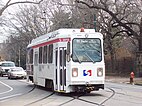SEPTA Metro
SEPTA Metro is an urban rail transit network in and around Philadelphia, Pennsylvania, United States, operated by the Southeastern Pennsylvania Transportation Authority (SEPTA). The network includes two rapid transit lines, a light metro line, a surface-running trolley line, and a subway–surface trolley line, totaling 78 miles (126 km)[b] of rail service.
Although some of Philadelphia's transit lines date to the 19th century and the SEPTA agency began operations in 1965, the transit network itself had no formal name until 2024, when it was named "SEPTA Metro" as part of an effort to make the system easier to navigate. The effort is also replacing each line's name with a single letter, plus a number to denote various service patterns. After a two-year transition that will replace signage throughout the system, the Market–Frankford Line, Broad Street Line, subway–surface trolley lines, Route 15 trolley, Media–Sharon Hill Line, and Norristown High Speed Line will be referred to as the L, B, T, G, D, and M, respectively.
History
[edit]In September 2021, SEPTA officials proposed to rebrand its rail transit services to make the system easier to navigate. The lines included the Market–Frankford Line, Broad Street Line, subway–surface trolley lines, Norristown High Speed Line, Route 15 trolley, and Media–Sharon Hill Line .[3][4]
Under this proposal, new maps, station signage, and line designations would be created. Under the proposed nomenclature, trunk lines would receive a letter and a color, with services having a numeric suffix and service name, to make wayfinding easier.[5] Services on the current Market–Frankford Line, for instance, would be called the "L Lines" and colored blue, with local service becoming the "L1 Market–Frankford Local".
Services along the current Broad Street Line would become the "B Lines" and colored orange, with local service becoming the "B1 Broad Street Local".[6] The express service would become the "B2 Broad Street Express", the special service would become the "B2 Express Sports Special", and spur service would become the "B3 Broad–Ridge Express". Services along the current subway–surface, Norristown High-Speed Line, Route 15 trolley, and Routes 101 and 102 suburban trolley trunk would become the "T Lines", "M Lines", "G Lines", and "D Lines" respectively.[6] SEPTA budgeted $40 million to June 2023 for the rebranding.[7]
In March 2022, SEPTA revised the SEPTA Metro proposal based on community feedback collected during September and October 2021. Under the amended proposal, each lettered service will be known as "Line" rather than "Lines". Special service along the Broad Street Line would become part of the "B2 Broad Street Express", with service being differentiated by their end terminals. Real-time information will be presented at stations on screens.[8] Stations with shared names would be renamed to avoid confusion.[5] SEPTA upgraded its website in late 2023,[9][10] before the planned rollout of SEPTA Metro in 2024.[11]
The first updated signs were installed at Drexel Station at 30th Street in February 2024.[12]
Lines
[edit]| Line name | Type | Service patterns | Terminal stations | Avg. weekday ridership (FY 2023)[13] | |
|---|---|---|---|---|---|
| South/West | North/East | ||||
| Rapid transit | 69th Street | Frankford | 107,651 | ||
| Rapid transit | NRG | Fern Rock | 79,155 | ||
| Walnut–Locust NRG (limited) | |||||
| 8th–Market | |||||
| Subway/ |
63rd–Malvern/Overbrook | 13th Street | 5,396 | ||
| 61st–Baltimore/Angora | 6,225 | ||||
| Yeadon Darby (limited) |
6,503 | ||||
| Darby | 6,669 | ||||
| 80th Street–Eastwick | 7,101 | ||||
| Trolley | 63rd–Girard | Richmond–Westmoreland | 4,762 | ||
| Trolley | Orange Street/Media | 69th Street | 2,023 | ||
| Chester Pike / Sharon Hill | 2,097 | ||||
| Light metro | 69th Street | Norristown | 4,510 | ||
References
[edit]Notes
[edit]Citations
[edit]- ^ "Route Operating Statistics". Retrieved September 15, 2024.
- ^ "SEPTA Operating Facts: Fiscal Year 2019" (PDF). SEPTA. 2019. p. 5. Archived (PDF) from the original on May 4, 2024. Retrieved July 15, 2024.
- ^ Chang, David (September 7, 2021). "The SEPTA Metro? L Lines and B Lines? SEPTA Proposes New Signage and Name Changes". NBC10 Philadelphia. Archived from the original on December 22, 2023. Retrieved December 22, 2023.
- ^ "SEPTA Proposing Series Of Changes Aimed To Make System Easier For Riders, Including Name Change To 'Metro'". CBS News. September 9, 2021. Archived from the original on December 22, 2023. Retrieved December 22, 2023.
- ^ a b Saunders, Brian A. (November 14, 2023). "SEPTA to update transit lines with simpler, more consistent signage". PhillyVoice. Retrieved December 22, 2023.
- ^ a b "Wayfinding Recommendations". SEPTA. Archived from the original on September 7, 2021. Retrieved September 7, 2021.
- ^ Fitzgerald, Thomas (September 7, 2021). "SEPTA proposes renaming its city rail lines to help everyone get around". Philadelphia Inquirer. Archived from the original on December 22, 2023. Retrieved December 22, 2023.
- ^ "Design Concept Feedback". planning.septa.org. Archived from the original on March 19, 2023. Retrieved March 15, 2022.
- ^ "Philadelphia's transit agency launches revamped website ahead of transition to 'SEPTA Metro'". 6abc Philadelphia. December 7, 2023. Retrieved December 22, 2023.
- ^ Lynch, Cherise (December 6, 2023). "SEPTA set to launch new user-friendly website". NBC10 Philadelphia. Retrieved December 22, 2023.
- ^ Lutz, Chandler (November 14, 2023). "SEPTA Metro aims to make Philadelphia's public transportation system easier to use". CBS News. Archived from the original on December 22, 2023. Retrieved December 22, 2023.
- ^ Fitzgerald, Thomas (February 14, 2024). "SEPTA's first signs of 'Metro' rebranding have arrived". The Philadelphia Inquirer. Archived from the original on February 20, 2024. Retrieved February 20, 2024.
- ^ SEPTA Data Group. "Route Operating Statistics: Fiscal Year 2023". Tableau Software. Archived from the original on June 3, 2024. Retrieved June 3, 2024.
External links
[edit]







